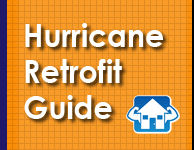|
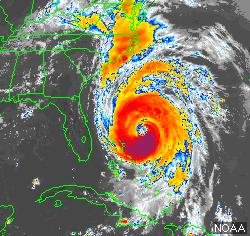
|
Hurricane Hugo, 1989
(click image for larger version) |
|

|
Hurricane Katrina, 2005
(click image for larger version) |
|
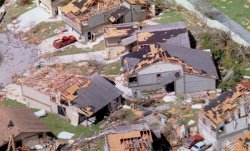
|
Homes Damaged by Hurricane Andrew in 1992
(click image for larger version) |
|
Hurricanes are well known for causing damage to homes and property, for destroying
family keepsakes, and for disrupting family life. But, as this website explains,
you can take action to protect your home. First, though, it helps to
learn a little more about the nature of hurricanes. These large, usually slow
moving storms bring high winds and wind driven rain that can impact your home
from a wide range of directions if the eye of the storm passes nearby.
As a result, the wind affects different homes in profoundly different ways,
depending on their design, location, and neighboring structures. In addition,
hurricanes can cause storm surge that affects coastal properties and rain
induced inland flooding.
The Power of the Wind: Among other things, the wind can knock out
or burst open windows and doors, rip off roof sheathing (decking) and destroy
gable end walls. Over-hanging eaves and gable end rakes, extended awnings,
open porches, and other features that tend to trap air beneath them are particularly
susceptible to being damaged or torn off the building during a hurricane.
Wind-borne debris from neighboring buildings, including shingles and tiles,
can break windows and damage roof coverings and walls. With or without the
help of wind blown objects, the wind can push in a garage door, window,
or door on the windward side of the house and move inside, increasing uplift
forces on the roof (in some cases doubling them). In fact, these powerful forces
can literally lift the roof right off of the house. When wind forces break
open part of your home, wind and water enter your home and damage to the
interior escalates dramatically. Because older less wind resistant homes tended
to break open regularly in high winds, a lot of the focus over the past couple
of decades has been on strengthening the structure and load resisting connections
in homes.

|
Drywall damaged by water intrusion
(click image for larger version) |
|
Pervasive Water: At nearly the same level of importance as direct wind
damage is the issue of water intrusion. Direct wind damage to the
structural elements of homes built to high wind standards has been reduced;
however it has become clear that just improving the structural integrity of
your home is not enough. Wind driven water intrusion can cause catastrophic damage
to the walls, ceilings and interiors of homes that leads to major disruption of
households. Furthermore, water intrusion can be of particular importance to
you as a homeowner because some insurance policies do not cover water intrusion
unless it originates from damage to the roof, walls, windows or doors of
your home. When wind speeds get above 60 mph, rain water is driven against the
exterior of you house with great force. Whenever water builds up on the
exterior wall surface and there is lower pressure on the inside of your house,
the water can penetrate in large quantities (quarts and gallons) through cracks,
holes and gaps in the siding and around windows and doors. When this happens
for hours at a time and usually there is no electricity available to dry
out homes using air conditioning or dehumidifiers, the resulting damage and
mold can be as devastating as wind damage. Water intrusion has recently become
recognized as the major issue it really is. While going through this website
take note of the water intrusion issues as much as you do the direct wind
load related issues.
Protecting your Home: The most important precaution you can take to
reduce damage to your home and property is to protect the areas where wind
can enter. According to research into hurricane induced damage, it's important
to strengthen the exterior of your house so wind forces and debris impacts do
not create large openings and so that wind driven rain does not cause water
intrusion. You can do this by protecting and reinforcing these six critical
areas:
- Roof
- Windows
- Doors
- Garage doors
- Soffits and attic vents
- Gable ends
A great time to start securing - or retrofitting - your house is now!
Don't wait until a hurricane is threatening before you take action. By taking actions
sooner than later you can get things taken care of in a less stressed environment
and complete them in a better way than when you are being threatened by
an impending hurricane. Combining retrofitting with other maintenance work
, home improvement projects or building an addition can reduce the costs of
the retrofits. In many cases, your local building code will require that your
work conform to certain requirements. And, although you may not need to
comply with current code requirements on the rest of your house, this may
be a good opportunity to strengthen critical parts or connections. Remember:
building codes reflect the lessons we have learned from past catastrophes and
represent minimum levels of protection required for all new construction.
Contact a design professional (architect or professional engineer) or your
local building code official to find out what the requirements are for your
home improvement projects.
Roof damage is by far the greatest risk that your home faces when a
hurricane strikes. Well over 90 percent of the homes that are damaged in
a hurricane suffer damage to the roof and particularly to the roof covering.
The second greatest risk is that wind and water will enter your home through
damaged or leaky doors and windows. This includes entry doors, sliding glass
doors, garage doors and all types of windows. The highest priority should be
placed on reinforcing, protecting or replacing double-wide (two car) garage
doors (probably the largest and one of the most vulnerable openings), double
entry doors such as French doors, and large windows. Failure of the larger
units can allow pressures that would have built up on the doors or windows to
enter the house and dramatically increase the loading on the roof structure,
interior walls and other exterior walls. Consequently, it is generally recommended
that you start with protecting the largest doors and windows first and then
work your way down to the smaller units.
Leaks: Cracks around windows and doors are areas where large amounts of
water can enter your home; even without structural failures. Additional potential
leak areas are: gable end attic vents, roof vents and soffit vents, along with
even small holes or cracks around dryer, kitchen and bathroom vents or places
where pipes and cables stick through the walls. Many homeowners do not know
that winds and rain outside the center of the storm can still be strong enough
to create a lot of damage to ageing or poorly installed roof coverings and
can produce enough water intrusion to create substantial damage and disruption of
households.
The issues discussed in the preceding paragraphs are usually the ones that
make the greatest difference to the most people's houses. This is because more
people experience high winds and wind driven rain from the edges of the storm
than the number who experience the most intense winds near the center of
the storm. However, if your goal is to give your home the best chance of
surviving the heart of an intense hurricane, then you need to concentrate a
good part of your efforts on retrofits that ensure that the parts of the
house are well connected together. Generally, homes built under high wind
standards developed in the mid 1990's are much better connected than those
built in the 1970's and 1980's. If your home is built in an area where these
newer standards have not been adopted or it was built before the new standards
were adopted, then it is more likely you'll have roof sheathing lifted off
and further suffer catastrophic damage that could endanger anyone inside and
dramatically slow your recovery after the storm.
Assessing the Risks
An important part of assessing the hurricane risks you face is to find out
the design wind speed for the area where your house is located.
Two different scales have been used over the years to define design wind speeds.
The latest codes all use gust wind speeds and all wind speeds referred to
on this website are gust speeds with an assumed averaging time of 3-seconds.
Building codes used in Florida before 2001 used something called a fastest-
mile wind speed that has an averaging time of between about 45 and 20 seconds,
depending on the wind speed. You can check with your building department to
determine what design wind speed was being used when your home was built.
If it is a fastest mile speed, add 20 to get close to the wind speeds used
in this guide.
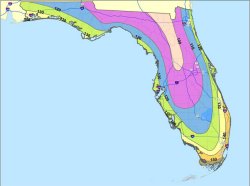
|
These design wind speeds are determined based on balancing the risk of high winds
in every area of the state. In general terms, the design wind speed for
a given location is the wind speed that has approximately a 1% chance of
being met or exceeded in any given year. Keep in mind that this does not
mean that your home will not experience wind speeds greater than the design
speed published in the code, it merely has less of a chance than areas with
higher design wind speeds. The following map shows the design wind speeds currently
published in the Florida Building Code.
(click image for larger version) |
If the design wind speed in your area is:
| 120 mph or higher |
then you have a high risk for hurricane wind damage and water intrusion
|
| Between 100 and 120 mph |
then you have a moderate risk for hurricane wind damage and high risk for water intrusion
|
| Between 90 and 100 mph |
then you have a low risk for hurricane wind damage, but moderate risk for water intrusion (high risk of water intrusion in slow moving hurricane)
|
In addition to risk based on design wind speed, recent research conducted for
the Florida Department of Community Affairs has demonstrated that terrain conditions
in inland locations can have a dramatic effect on the risk of hurricane damage.
If you live in an area with few trees and large open spaces, your home
is at a much greater risk of wind borne debris impact than homes built in
areas with trees. However, if you live in an area with even light to moderate
tree coverage, which reduces your risk of wind borne debris impact, you have
increased risk associated with trees potentially falling and damaging your home.
A careful review of the damage that has happened over the years in numerous hurricanes
reveals patterns that can be used to help set priorities.
- Roof Coverings: Roof covering damage is observed in 95+
percent of all homes that suffer significant damage and loss.

|
(click image for larger version) |
- Roof Sheathing: Wind can pull sheathing off roofs when the
sheathing is not nailed to high wind standards.
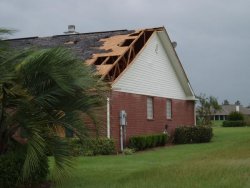
|
(click image for larger version) |
- Broken Glass: When gust wind speeds climb above 120 mph,
about one third of homes without window protection suffer broken glass
to at least one window.
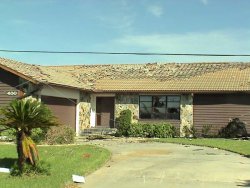
|
(click image for larger version) |
- Double Entry Doors: When gust wind speeds climb above 120
mph, older (not current code approved) double entry doors may burst
open, allowing wind and water to enter the home.
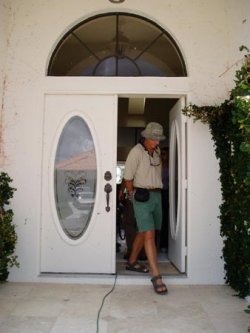
|
(click image for larger version) |
- Garage Doors: Two car garage doors that have not been braced
or are not high wind rated, frequently fail as gust wind speeds climb
above 120 mph.
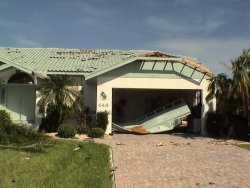
|
(click image for larger version) |
- Anchorage of Roof Structure: Homes that lose the entire roof
frequently don't have hurricane straps holding down the roof structure
and almost always have a window or a door that is broken open on
the windward side of the home which has allowed wind pressures to
increase significantly inside the house.
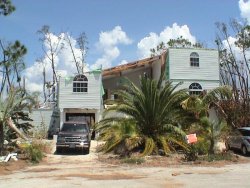
|
(click image for larger version) |
- Soffits: Vinyl and aluminum soffits are frequently installed so
poorly that they are not able to resist positive and negative (
suction) pressures created when gust wind speeds exceed about 100
mph. Soffit damage can also occur in thunderstorms, especially to
upper soffits on a two story house. When soffit panels become dislodged,
strong winds can cause rain to blow up into the attic where damaging
amounts of water can enter the house.
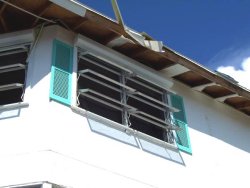
|
(click image for larger version) |
- Attic Ventilation: Ridge vents, off ridge vents and gable end
vents can let a lot of water into the attic which can lead to the
collapse of ceilings in homes that otherwise look fine from the outside.

|
(click image for larger version) |
- Gable Ends: Gable end walls over about 5-feet tall at the
peak are a frequent area where damage is concentrated. The roof sheathing
may be lifted off at the gable end, opening up the attic to wind and
rain. The bottom of the gable wall may break loose from the wall
below. The members used to support the gable end wall exterior finish
and/or their connections may fail. Typically, houses built in areas
where the high wind building code provisions developed in the early
1990's have not been adopted and followed, have gable end walls that
are not properly anchored to the top of the wall below and the wall
has not been properly braced. If this wall and/or gable end is
pulled away from the house by the wind, it will open up the entire end
of your house.
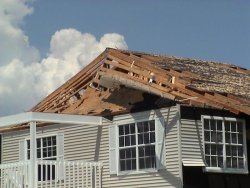
|
(click image for larger version) |
- Porch Roofs: Most porches and overhangs are poorly anchored and
can get torn off the house, causing damage that extends well into
the house. In many cases this will result in catastrophic damage to
the house. The uplift forces on these wing-like roofs can be tremendous
compared to the ability of their supporting posts, and especially the
connections to the posts, to hold them down. Don't be deceived by
seeing straps or other connectors. They are frequently undersized and
should be checked for adequacy.
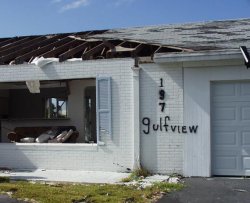
|
(click image for larger version) |
- Aluminum Structures: Aluminum structures such as carports and
pool enclosures are often inadequately anchored, braced and connected.
They are often the first structures to be blown down and then blow
into your house and possibly your neighbor's.

|
(click image for larger version) |
- Surroundings: While nearby buildings may help break up the
wind by acting as shields, they can also channel the wind so that
it becomes more intense in some areas. Furthermore, other buildings can
be a source of debris that is picked up by the wind and hurled at
your windows and doors. As long as trees are still standing, they
can have an overall calming effect by slowing down the wind near the
ground. However, they can also be a source of trouble by shedding branches
which become wind-borne debris and if they are too close they can
fall on your house. Tall pine trees are one of the most dangerous sources
of tree damage as they have often sliced through roofs and walls.
However, the fact that an oak tree has survived for a century or
more is no guarantee that it won't fall on your house. It has been
seen many, many times.

|
(click image for larger version) |
Roofs: Tile roofs generally perform better than pre FBC/IRC (Florida Building
Code/International Residential Code) shingle roofs of the same age until gust
wind speeds exceed about 120 mph. At that point, experience with existing roofs
indicates that they both start blowing off. If the shingle roof is covered with
one of the newer high wind rated products, and it was installed properly there
is a reasonably good chance that it will survive (at present, the newer high
wind rated roofs have only been available for a few years so it is not possible
to know how well they will hold up in the long run). Also, if the tile roof
is well attached with mechanical fasteners (screws or nails), the ridge and
edge tiles are mechanically fastened to a support structure such as a ridge
board, and the tiles are not hit by flying debris, there is a reasonable chance
that it will survive. It will take a professional roofer to determine how
adequately the tiles are attached.
While replacing a tile roof can cost two to four times as much as replacing a
shingle roof, the typical underlayment for a tile roof is much more apt to
stay on the roof and is more resistant to water penetration after the roof
covering is damaged than that applied under a shingle roof. Consequently,
houses with damaged tile roofs are less likely to suffer damage to the interior
from water entering from the top surface of the roof than houses with damaged
shingle roofs. The difference in performance is because roof tiles are usually
just a covering that has been placed over a weatherproof roof membrane whereas
shingles are the weatherproof roof. When shingles are lost, the weatherproofing is
lost. The exception is that when tile are over a ridge that has vents cut
into the roof that serve as a way of venting (cooling) the attic. Losing those
tiles can leave a hole for rain to enter the house.
Metal roof coverings are gaining a reputation as being resistant to high winds.
However, the performance depends on how the metal is connected to the
structure. The metal edges and ridge covers are somewhat more vulnerable than
the rest of the metal roof. The underlayment is typically the same used under
shingles, so it can easily be damaged if exposed by loss of the metal roof
covering.
If you have an older shingle roof, one of your top priorities should be
taking steps to reduce the risks that it will be damaged in a hurricane.
Loss of shingles could lead to water flooding into the house from above,
resulting in collapsed ceilings, water soaked walls and everything inside the
house. If not dried out right a way mold is likely to develop and require gutting
of the house to remove the remaining drywall on the ceilings and walls.
This damage is of nightmare proportions.
While the roof covering is the first line of defense against the storm,
the switch from wood planks to structural wood panels (plywood and Oriented Strand
Board - OSB) in the 1970's was done without adequate requirements for anchoring
the panels to the trusses and rafters. In addition, a large number of homes
were built in the 1980's and 1990's where the sheathing was stapled to the
trusses and rafters instead of using nails. The use of staples has been shown
to be one of the poorest connections for roof sheathing. Unfortunately,
it is still being used in some hurricane prone regions, although it is now
prohibited from use in new construction and remodeling of roofs in Florida.
Loss of even one piece of roof sheathing can result in internal damage to
your home and contents that is nearly ten times the cost of the damage to
the exterior of your home. Consequently, one of the items in the checklist is
to try and determine what kind, size and spacing of fasteners (nails or
staples) is used to attach the roof deck to the trusses or rafters. The
roof deck attachment should always be brought up to the latest code requirements for
your area or by simply re-nailing the deck with ring-shank nails as described in
this guide. The greatest risk of losing roof sheathing is on houses with
gable ends where the sheathing has been attached with staples and is compounded
by inadequately anchored overhangs. Click on
What To Do When Re-Roofing
to learn how to improve your roof sheathing performance when re-roofing your home.
If it will be some years before you re-roof and you have these features, the
website does give some suggestions for stop-gap measures in
What to Do If You Don't Re-roof.
Windows and Doors: Protecting windows and doors (including sliding glass
doors and garage doors) is an important part of protecting your home, your
belongings, and your roof in a hurricane. Your home is particularly vulnerable
to windows being broken by windborne debris if your design wind speed is
120 mph or greater, you live in a neighborhood without dense tree cover,
and you have neighbors with tile, gravel or older shingles on their roofs.
Also, if your home is an older home or was built in an area where they have
not been following a modern high-wind building code, you may not have hurricane
clips or straps holding your roof structure to your walls. If that is the
case, window and door protection may make the critical difference between losing
your roof and keeping it on. Installing shutters over windows and doors can
protect them from the impacts of windborne debris but may not keep the doors
and windows from bursting open from wind pressure if they are weak or poorly
anchored to the walls of the house.
Keeping Water Out: A high quality wind resistant roof covering attached
to a well anchored roof deck and protection of windows and doors are the
most critical elements in reducing your chances of having extensive water damage.
However, even if these are in place, other sources of water leaks can combine
to overwhelm the ability of your wall system to resist prolonged exposure to
wind driven rain from a slow moving hurricane. A tremendous amount of water
can be forced through cracks and holes in your wall and around windows,
doors, vent holes and places where cables or pipes pierce your exterior wall.
The remedies that include caulking and sealing are not very difficult to
do and can be accomplished pretty quickly. Consequently, these actions should
be given a reasonably high priority as you head into hurricane season.
Caulking and sealing is a good practice, even if you have storm panels in
place, because wind driven rain can get behind most if not all types of
panels.
Structural Retrofits: Except for improving the anchoring of porch roofs
and overhangs, or bracing gable ends, carrying out structural retrofits that
will provide a meaningful upgrade in the strength of your home are usually very
expensive and difficult to accomplish. To be effective, they normally require
opening up the exterior or interior wall surfaces although some can be done
by opening up the soffit area. Usually, structural retrofits that involve improving
the anchorage of the roof structure to the walls, strengthening the connections between
walls at the corners of your house, upgrading the wall strength and resistance to
flying debris, and improving the anchorage of the walls to the foundations are
best accomplished at relatively small additional cost when you remodel,
re-side your home, or when you are rebuilding after your home has been damaged.
Food for Thought
This website contains suggestions for a number of home improvement projects.
If you do them correctly, you can greatly reduce the extent of hurricane damage.
However, nothing can guarantee total protection. Please follow the instructions
of your local authorities if told to evacuate, even if you have completed these
projects. More people die from storm surge and flooding in hurricanes than
die from wind induced damage. There is a wise old saying, "run from the
water and hide from the wind" that is still appropriate today. We have talked
with homeowners who bought some of the latest impact resistant products and
then proceeded to watch the storm through the protected openings; they watched
their neighbors swing set pull out of the ground and fly towards their house.
This is not a good example of hiding from the wind - you want to put as
many solid walls as possible between you and the exterior wall facing into
the wind during the hurricane.
Also, remember that this website provides general recommendations that may
need to be modified or refined depending on the construction details for
your house. You or a building contractor may be able perform many of the
retrofits outlined in this guide. However, if your house is complex or
unusual, or if you are uncertain about how the ideas presented here apply to
your house, you should consult with your building department or a registered design
professional to determine what may be appropriate for your particular situation.
|
